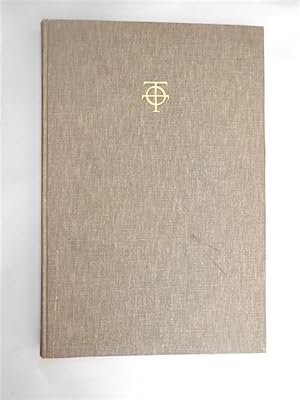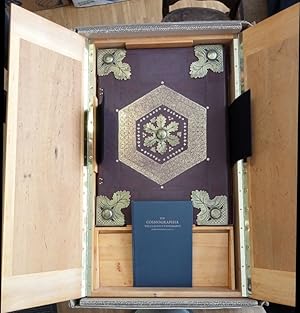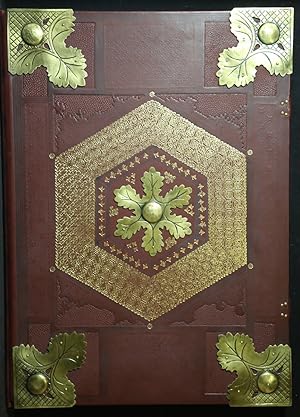claudius ptolemaeus cosmographia (6 Ergebnisse)
FeedbackSuchfilter
Produktart
- Alle Product Types
- Bücher (6)
- Magazine & Zeitschriften (Keine weiteren Ergebnisse entsprechen dieser Verfeinerung)
- Comics (Keine weiteren Ergebnisse entsprechen dieser Verfeinerung)
- Noten (Keine weiteren Ergebnisse entsprechen dieser Verfeinerung)
- Kunst, Grafik & Poster (Keine weiteren Ergebnisse entsprechen dieser Verfeinerung)
- Fotografien (Keine weiteren Ergebnisse entsprechen dieser Verfeinerung)
- Karten (Keine weiteren Ergebnisse entsprechen dieser Verfeinerung)
- Manuskripte & Papierantiquitäten (Keine weiteren Ergebnisse entsprechen dieser Verfeinerung)
Zustand
- Alle
- Neu (Keine weiteren Ergebnisse entsprechen dieser Verfeinerung)
- Antiquarisch (6)
Einband
- alle Einbände
- Hardcover (3)
- Softcover (Keine weiteren Ergebnisse entsprechen dieser Verfeinerung)
Weitere Eigenschaften
- Erstausgabe (Keine weiteren Ergebnisse entsprechen dieser Verfeinerung)
- Signiert (Keine weiteren Ergebnisse entsprechen dieser Verfeinerung)
- Schutzumschlag (Keine weiteren Ergebnisse entsprechen dieser Verfeinerung)
- Angebotsfoto (5)
Sprache (2)
Preis
- Beliebiger Preis
- Weniger als EUR 20 (Keine weiteren Ergebnisse entsprechen dieser Verfeinerung)
- EUR 20 bis EUR 45 (Keine weiteren Ergebnisse entsprechen dieser Verfeinerung)
- Mehr als EUR 45
Gratisversand
Land des Verkäufers
Verkäuferbewertung
-
EUR 189,00
Währung umrechnenEUR 30,00 für den Versand von Schweiz nach USAAnzahl: 1 verfügbar
In den WarenkorbAmsterdam, Israel, Meridian 1963. Gr.Folio. XII, 1 Bl., (120) S. (engl.) und 26 doppelblattgr. Karten. Original Leinen. (Theatrum Orbis Terrarum. First Series. Vol. 1). Sehr gutes Exemplar.
-
Die Cosmographia des Claudius Ptolemaeus 1472. (Facsimilie of Codex Urbinas Latinus, no 277, in Bibliotheca Apostolica Vaticana, Rome)
Anbieter: Herman H. J. Lynge & Søn ILAB-ABF, Copenhagen, Dänemark
EUR 2.204,55
Währung umrechnenKostenlos für den Versand von Dänemark nach USAAnzahl: 1 verfügbar
In den WarenkorbZurich & New York, Besler and Johnson, 1982-1983. Large folio (620 by 460 mm). In the original magnificent full calf binding with blind-tooled ornamentation, gilt centrepiece, brass centre and corner pieces and two leather clasps. No. 54 out of 500 copies. A fine and clean copy. 135, (2) pp. With a total of 44 maps of which 29 are double-page. 1 leaf, the world map, loosely inserted as usual. Accompanying the atlas is a commentary-volume in half calf. 88, (6) pp. An outstanding facsimile of the Vatican's Ptolemy Cosmographia of 1472, no. 277 in the Vatican Library. This present copy being no. 54 of only 500 copies produced. The manuscript was written by Ugo Comminelli from Mézières in Florence and completed in 1472/73. Maps and decorations were designed by important Italian artists such as Francesco Rosselli and Pietro del Massaio.
-
CLAUDIUS PTOLEMAEUS - COSMOGRAPHIA Codex Lat. 463 = a.X.1.3, Biblioteca Estense Universitaria, Modena.
Verlag: Modena, il Bulino,, 2004
Anbieter: Anton Pfeiler, Simbach, Deutschland
EUR 1.980,00
Währung umrechnenEUR 45,00 für den Versand von Deutschland nach USAAnzahl: 1 verfügbar
In den Warenkorb446 x 305mm. 110 Seiten. 27 Karten, davon 26 doppelseitig, reich mit Gold verziert. Entstehung: 1466 in Florenz für Borso d'Este von Nicolo Germanico zusammengetragen und in der Werkstatt von Francesco Antonio del Chierico mit Miniaturen und Randdekorationen verziert. Im 15. Jahrhundert wurde in Florenz die ptolemäische Überlieferung in den griechischen Handschriften wiederentdeckt und ins lateinische Übertragen. Hier wurden die schönsten Cosmographien des Ptolemäus der Kunst- und Wissenschaftsgeschichte zusammengetragen und kopiert um die rege Nachfrage der mächtigsten Fürsten der Renaissance, von Borso bis da Montefeltro, von Corvinius bis Ludwig XII. zu befriedigen. Faksimile + Kommentar. Leder in Seidenkassette. Limitierte Auflage 499 Exemplare. Neuwertiges und unbenutztes Exemplar. Sprache: Deutsch Gewicht in Gramm: 0.
-
Die Cosmographia des Claudius Ptolemaeus 1472/3
Verlag: Besler and Johnson,, Zurich & New York
Anbieter: Daniel Crouch Rare Books Ltd, London, Vereinigtes Königreich
EUR 7.223,32
Währung umrechnenEUR 23,38 für den Versand von Vereinigtes Königreich nach USAAnzahl: 1 verfügbar
In den WarenkorbSuperb facsimile of the Vatican's Ptolemy Cosmographia of 1472 Folio atlas (620 by 460mm), 135pp., [2] leaves, full colour facsimile reproduction of the Vatican Codex Urb. Lat. 277., full blind tooled calf with gilt centrepiece, brass centre and corner pieces, leather clasps. Superb facsimile of Ptolemy's Cosmographia, published by the Vatican. The original manuscript was commissioned by the Duke of Urbino in 1472/3, and came into the Vatican Library in 1657. In 1983 the Vatican Library published 550 facsimiles; 500 of which were meant for sale and fifty - each marked with a Roman numeral I-L - to be kept by the Library, for use as state gifts. The present copy is marked with the Roman numerals 'VII'. One such example was presented by Pope Benedict XVI to Christian Wulff, the President of Germany, during his Apostolic visit to Germany, on the 22nd September 2011. The press release that accompanied the gift gives a general history of the work: "This facsimile reproduces the manuscript containing the Latin translation of the Greek text (version "A") of the Geographia by Claudius Ptolemy (2nd century AD), performed by Iacopo Angeli da Scarperia (around 1360-1410). The title Cosmographia, which seemed the most appropriate to the author, was based on choices made by other Latin authors for similar works (the reasons why are explained in folio 2v). Together with other, similar specimens this magnificent manuscript documents the rediscovery and positive reappraisal during the Renaissance of Ptolemy's cartographic oeuvre, as a synthesis of Hellenistic culture and a recognised milestone in the representation of the earth, unique among its kind in terms of the wealth of theoretical and practical information it provides on the topic. The codex was transcribed in Florence in an elegant, humanist script by Hugues Commineau (Ugo Comminelli) de Mézières (see colophon folio 70r; in abridged form folio 122r), the same copyist of the splendid Bible of Urbino (Urb. Lat. 1-2). Pietro del Massaio and Francesco Rosselli were also involved in its production: both were well known as illuminators thanks to their workshops, which were specialised in the manufacture of maps and geographical works. The embellishment is valuable; this begins with the title page (folio 1v), which contains a sumptuously enframed reference to the title and the translator in gold on a blue background; the incipit of the translator's foreword (folio 2r) is decorated along the edges with gold and coloured borders comprised of flowers, putti with candelabras (also a recurrent motif in the initials of the text) and medallions, plus an illumination showing the translator presenting the work to Pope Alexander V (wrongly identified as Alexander III). The incipit of each book includes delightful initials painted in miniature; colourful frames embellish the introductory texts to the maps that follow. The text is divided into eight books. Book I (folios 3r13r) explains the theoretical concept of 'geographia' and methods for designing maps; books IIVII (folios 13r-69r) contain information on the names of towns and cities, countries, regions and peoples of the world together with their coordinates; book VIII (folios 69r-70r) details the number of maps and provinces for each continent, and includes short descriptions and data on the main cities etc. These books are followed by the 27 maps traditionally ascribed to Ptolemy: the entire world as it was then known (folios 72v-73r), then 10 maps of Europe (folios 74v-92r; Germany is on folio 80r), 4 maps of Africa (92v-100r), 12 of Asia (100v-121r). Then come seven non-traditional maps or 'novae' (folios 122v-129r), and 10 city- and townscapes (folios 129v-135r). The sequence is determined by a practical cartographic criterion. The more than 8,000 locations named are entered in a grid of longitudes and latitudes, which Ptolemy is the first to use in the modern sense. The codex belonged to the library of Federico da Montefeltro, Duke of Urbino (1422- 1482), which was acquired by Pope Alexander VII and thus reached the Vatican library in 1657. The present binding of the work, made of brown leather embellished with the coats of arms of Pope Pius VI (1775-1799) and the cardinal librarian Francesco Saverio de Zelada (1779-1801), is dated at between 1779 and 1799; we know of two previous bindings. For a limited number of copies of the facsimile a valuable binding was selected, manufactured after the original of another work by Ptolemy from the late 15th century and taken from the same library (Urb. Gr. 82) [Claudia Montuschi (BAV)].".
-
Ptolemaeus, Claudius: Cosmographia. Faksimile der Handschrift Codex Urbinas Latinus 277 aus der Bibliotheca Apostolica Vaticana, Rom. Kommentar hrsg. v. A. Dürst.
Verlag: Zürich, Belser 1982 - 83., 1982
EUR 2.800,00
Währung umrechnenEUR 20,00 für den Versand von Deutschland nach USAAnzahl: 1 verfügbar
In den Warenkorb2 Bände (Faksimile- und Kommentarband). Gr.-Folio bzw. 4°. 135 Blatt mit 44 Karten., 88 S. Old. mit Messingbeschlägen bzw. Oln. Exemplar der Vorzugsausgabe mit Holzschmuckkassette, die als Stehpult aufgebaut werden kann. 1 von 550 Ex.Kommentarband leicht bestoßen.
-
Die Cosmographia des Claudius Ptolemaeus. Cod. Urb. lat. 277. Faksimile der Handschrift aus der Biblioteca Apostolica Vaticana, Rom.
Verlag: Zürich, Verlag Belser 1982-1983., 1982
Sprache: Deutsch
Anbieter: Antiquariat Braun, Gengenbach, Deutschland
EUR 2.500,00
Währung umrechnenEUR 143,00 für den Versand von Deutschland nach USAAnzahl: 1 verfügbar
In den WarenkorbZustand: Wie neu. Faksimileband: 62 x 45 cm. 135 numerierte Blatt mit 44 Karten, davon 29 doppelseitig, - Kommentarband: 88 Seiten. *Eins von 500 numerierten Exemplaren (Weltauflage 550). Die Handschrift aus der Biblioteca Apostolica Vaticana entstand als ein Meisterwerk italienischer Renaissance-Buchmalerei im Auftrag des Herzog von Urbino ca. 1472, die Herstellung wird dem Florentiner Maler Pietro del Massaio dieses eindrucksvolle Meisterwerk zugeschrieben. Die Handschrift war ein Kompilation des Ptolemäischen Weltbildes aus alten Quellen. "Claudius Ptolemäus (etwa 100 - 180 n. Chr.) war Mathematiker, Astronom und Geograph. Insbesondere seine drei Werke zur Astronomie, Geografie und Astrologie galten in Europa bis zur frühen Neuzeit als wissenschaftliche Standardwerke und wichtige Datensammlungen. Dieses Werk blieb bis zum Ende des Mittelalters das Standardwerk der Astronomie im europäischen Raum. Es enthielt neben einem ausführlichen Sternenkatalog eine detaillierte Ausarbeitung des geozentrischen Weltbildes, das später nach ihm "Ptolemäisches Weltbild" genannt wurde. Das vorliegende Faksimile in der sogenannten "Prachtedition des Ptolemäischen Weltatlas" wurde in einem Prchteinband entsprechend dem Original nachgebildet. - Verlagsfrisches Exemplar. / (High weight of ca. 12 kg: International shipping costs Non-EU: ca. 70-80 Euro). Sprache: Deutsch Gewicht in Gramm: 12000 Großformatiger blindgeprägter Lederband mit 10 Messingbeschlägen und 2 Messingschließen.







